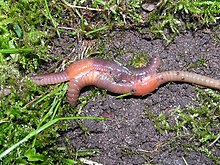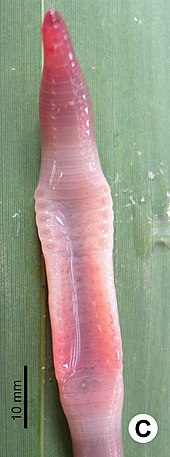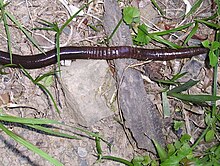Crassiclitellata
| Crassiclitellata | ||||||||||||
|---|---|---|---|---|---|---|---|---|---|---|---|---|

Compost worm ( Eisenia foetida ) |
||||||||||||
| Systematics | ||||||||||||
|
||||||||||||
| Scientific name | ||||||||||||
| Crassiclitellata | ||||||||||||
| Jamieson , 1988 |
The Crassiclitellata are a taxon originally categorized as a suborder in 1988, today mostly as an order within the little bristle (Oligochaeta) in the class of belt worms (Clitellata) with regular segmentation and a thick-walled clitellum , whose representatives mostly live as substrate eater in the soil and humus and worldwide occur. In addition to the Lumbricidae or " earthworms " in the narrower sense, which are native to Eurasia and North America, this group includes numerous other families, which are also referred to as earthworms in the broader sense. The description of this taxon by Barrie GM Jamieson largely corresponds to the description and corresponding limitation of the subordination Lumbricina Burmeister , 1837 by Reginald William Sims (1981).
features
The clitellum in the Crassiclitellata consists of several cell layers and is therefore thicker (Latin: crassus , "thick") than in the other belt worms. The eggs, on the other hand, are small and poor in yolk, while the surrounding fluid within the cocoon contains a lot of yolk and is used to nourish the developing embryos.
The Crassiclitellata show the typical original features of the paraphyletic few bristles. They have a fully developed coelom, septate according to segments and acting as a hydroskeleton, as well as a primary closed blood vessel system . They are regularly segmented and have four pairs of bristle sacks on each segment, with which the animals anchor themselves in the ground and which give the necessary support when moving. This takes place with the longitudinal and circular muscles of the skin muscle tube .
Like all beltworms, the Crassiclitellata are hermaphrodites and have two pairs of testes - one each in the 10th and 11th segment - and a pair of ovaries in the 13th segment. They usually have two pairs of vas deferens that penetrate more than one segmental septum and open outwards at only one pair of genital orifices or even just a single middle genital opening in the 15th or a further back, often the 18th segment. The fallopian tubes, on the other hand, only penetrate one segment septum and open outward in the 14th segment. The two, more rarely four, pairs of seed bags ( Receptacula seminis ) are located in the 9th and 10th segment, and more rarely in the two preceding segments.
During copulation, two animals attach to each other with a secretion from the clitellum in the opposite direction and exchange sperm, which are absorbed into the receptacula seminis of the sex partner. Separate management of the egg cells and sperm prevents self-fertilization. A secretion from the clitellum forms an egg cocoon into which the crassiclitellate first releases its own eggs and then the sperm of its sex partner from its receptacula seminis, thus enabling fertilization in the cocoon. Here the embryos develop into finished small worms.
Distribution, habitat and way of life
The Crassiclitellata are common on all continents with the exception of Antarctica. While the Lutodrilidae and Criodrilidae as well as the Almidae live underground in various inland waters, the remaining Crassiclitellata are land-dwellers who live in the soil and humus . Almost all Crassiclitellata are substrate eaters that feed on the microorganisms and the decaying organic material in the ingested substrate. Crassiclitellata play a prominent role as destructors and looseners of the soil in ecosystems worldwide.
Systematics
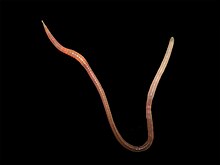
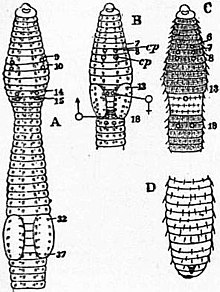
A Lumbricus ( Lumbricidae ), saddle-shaped clitellum, 32. – 37. Segment, ♀ pores 14., ♂ pores 15., Rec.sem. 9-10 Segm .; B Acanthodrilus ( Acanthodrilidae ), saddle-shaped clitellum, 13th – 18th centuries. Segment, ♀ pores 14., ♂ pores 18., Rec.sem. 8th-9th Segm .; C Perichaeta ( Megascolecidae ), ring-shaped clitellum, 13th-16th centuries. Segment, ♀ pores 14., ♂ pores 18., Rec.sem. Furrows 6th – 9th Segm .; D Urochaeta ( Glossoscolecidae ), hind end. Encyclopædia Britannica 1911, Chaetopoda , Fig. 10.
The taxon Crassiclitellata was established in 1988 by Barrie GM Jamieson as part of a revision of the oligochaeta system as a subordination within the order Opisthopora. He recognized the characteristic thick-walled clitellum made up of several cell layers as the autapomorphy of the monophylum crassiclitellata. This view was confirmed by later molecular genetic studies, including by Jamieson et al. 2002 and Erséus and Källersjö 2004. In contrast, the two sub-taxa of water-dwelling and land-dwelling forms (Aquamegadrili and Terrimegadrili) initially postulated by Jamieson were not confirmed. A comparative molecular genetic work by Frank E. Anderson et al. 2017 resulted on the one hand in an early split-off subgroup, which includes the North American families Komarekionidae and Sparganophilidae as well as the Malagasy family Kynotidae , from the other subgroup again two sub-taxa, in which the Crassiclitellata are distributed according to their geographical distribution in inhabitants of the northern hemisphere (Laurasia: Lumbricidae , Hormogastridae , Criodrilidae and Lutodrilidae ) and in those of the southern hemisphere (Gondwana: Microchaetidae , Rhinodrilidae , Almidae , Glossoscolecidae , Eudrilidae , Megascolecidae , Ocnerodrilidae and Acanthodrilidae ). Such a correlation between geographical distribution and genetic relationship, which continues to this day, is associated with the way of life of the Crassiclitellata in the soil and the associated limited ability of the animals to spread. According to this, the original girdle worms were water dwellers, and only the Crassiclitellata developed into land-living forms. While the Lutodrilidae and Criodrilidae as the closest relatives of the rural Lumbricidae and Hormogastridae have life in the water as their original characteristic, the Almidae returned to the water secondarily. The division into the two main branches is settled at almost 200 mya , which roughly corresponds to the division of Laurasia and Gondwana on the border between Triassic and Jura.
Familys
The Crassiclitellata comprise the following families :
- Northern clade (Laurassia)
- Criodrilidae Vejdovský, 1884 (limikol / aquatic; Europe, Japan)
- Hormogastridae Michaelsen, 1900 (terrestrial; Europe)
- Lumbricidae Rafinesque-Schmaltz , 1815 (terrestrial; Eurasia and North America)
- Lutodrilidae McMahan, 1976 (aquatic; North America)
- Southern clade (Gondwana)
- Acanthodrilidae Claus, 1880 (terrestrial; Australia, New Zealand, South Africa, South America, North America)
- Almidae Duboscq, 1902 (aquatic; Africa, South Asia, Southeast Asia; includes former Glyphidrilidae)
- Eudrilidae Claus, 1880 (terrestrial; Africa)
- Glossoscolecidae Michaelsen, 1900 (terrestrial; South America, Central America)
- Megascolecidae Rosa, 1891 (Terrestrial; Australia, New Zealand, Southeast Asia, East Asia, North America)
- Microchaetidae Beddard, 1895 (terrestrial; southern Africa)
- Ocnerodrilidae Beddard, 1891 (terrestrial; South America)
- Octochaetidae Michaelsen, 1900 (terrestrial; South Asia, Southeast Asia, Madagascar)
- Rhinodrilidae Benham, 1890 (terrestrial; South America)
- Basal group with species from North America, Madagascar and Japan
- Biwadrilidae Jamieson, 1971 (aquatic; Japan)
- Komarekionidae Gates, 1974 (terrestrial; North America)
- Kynotidae Jamieson, 1971 (terrestrial; Madagascar)
- Sparganophilidae Michaelsen, 1921 (aquatic; North America)
Cladogram
From the work by Anderson et al. 2017 results in the following cladogram :
| Crassiclitellata |
|
|||||||||||||||||||||||||||||||||||||||||||||||||||||||||||||||||||||||||||||||||
|
|
literature
- Frank E. Anderson, Bronwyn W. Williams, Kevin M. Horn, Christer Erséus, Kenneth M. Halanych, Scott R. Santos, Samuel W. James (2017): Phylogenomic analyzes of Crassiclitellata support major Northern and Southern Hemisphere clades and a Pangaean origin for earthworms. BMC Evolutionary Biology 17, p. 123
- Frederick W. Harrison, Stephen L. Gardiner: Microscopic Anatomy of Invertebrates, Volume I. Annelida. Wiley-Liss, New York City 1992. p. 7.
- Barrie GM Jamieson (1988): On the phylogeny and higher classification of the Oligochaeta. Cladistics 4, pp. 367-410.
- Barrie GM Jamieson, Simon Tillier, Annie Tillier, Jean-Lou Justine, Edmund Ling, Sam James, Keith McDonald, Andrew F. Hugall (2002): Phylogeny of the Megascolecidae and Crassiclitellata (Annelida, Oligochaeta): combined versus partitioned analysis using nuclear (28S) and mitochondrial (12S, 16S) rDNA. Zoosystema 24 (4), pp. 707-734.
- Reginald William Sims (1981): A classification and the distribution of earthworms, suborder Lumbricina (Haplotaxida: Oligochaeta). Bulletin of the British Museum (Natural History), Zoology Series 39 (2), pp. 103-124, here p. 107, Lumbricina - Earthworms .
